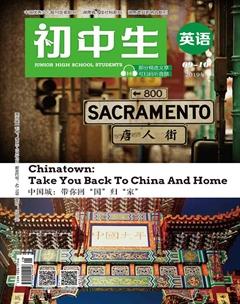你问我答
主持人:邓金飚,湖南醴陵市渌江中学优秀老师。2018年参加“一师一优课,一课一名师”竞赛,获得特等奖。
Q1:老师,这道题的答案是A,我认为是B。请问,究竟哪个正确?
They still went on working, because they felt not tired.
A. a bit B. a little C. little D. a bit of
A1:你把not a little和not a bit的词意弄混了。A bit与a little在肯定句中意思基本相同,均有“稍微;一点儿”的意思,常常可以互换。如:
He did his homework a bit / a little carelessly. 他做作业时有点粗心。
在否定句中,二者的意思正好相反。Not... a bit意为“一点儿也不”,而not... a little相当于very much,意为“很;非常”。比较下面两个句子:
1)He isnt a bit hungry. 他一点儿都不饿。
2)He isnt a little hungry. 他饿极了。
当修饰不可数名词时,a little可直接修饰名词,而a bit之后需要加上of才能与名词连用。如:
Theres only a little / a bit of food left for lunch. 午餐只剩一点儿食物了。
正确答案应选A。
Q2:老师,下面这道题我不会做,您能给我详细讲讲吗?
Its a little late! The movie for a few minutes.
A. has been on B. began
C. was beginning D. has begun
A2:正确答案是A。分清楚非延续性动词和延续性动词的用法及其转换规律,是解答此题的关键。
非延续性动词是表示短暂动作的动词,动作通常在一瞬间就能完成,不能与表示一段时间的状语连用。如:
1)He left Hunan two days ago. (√)
2)He has left Hunan for two days. (×)
延续性动词表示动作可以延续一段时间,能够和表示一段时间的状语连用。如:
My grandparents have lived in the city for over fifty years. 我的祖父母在这个城市已经生活了50多年。
在肯定句中,非延续性动词只有转换成能够表示持续意义的动词或短语,才能与表示一段时间的状语连用。常用的方法有以下几种:
● 转换成“be + 名词/形容词/副词/介词短语”的系表结构:join the army→ be a soldier / in the army, die→ be dead, leave→ be away等。如:
The man took part in the army 10 years ago.
→ The man has been in the army for 10 years.
● 用延续性动词替换非延续性动词:borrow→ keep, buy→ have等。如:
Millie borrowed this book a week ago.
→ Millie has kept this book for a week.
● 用“It is / has been + 一段时间 + since + 从句”表示。如:
She joined the Reading Club two years ago.
→ It is two years since she joined the Reading Club.
● 用“一段时间 + has passed + since + 从句”表示。如:
Alan came here six months ago.
→ Six months has passed since Alan came here.
Q3:老师,怎样判断if引导的是条件状语从句还是宾语从句?
A3:一般而言,判断if引导的是条件状语从句还是宾语从句有三种方法:
第一,从意义上判断。If引导条件状语从句时,译成“如果;假如”;而if引导宾语从句时,译成“是否;能否”。
第二,从位置上判断。If引导的条件状语从句,既可以放在主句前,也可以放在主句后;而if引导的宾语从句不能放在句首。
第三,从时态呼应关系判断。If引导条件状语从句时,若主句是祈使句、主句中有情态动词或主句中的谓语动词是一般将来时,从句中的谓语需用一般现在时代替一般将来时;而if引导的宾语从句则要根据具体情况来选用时态。如:
1)Please stop to have a rest if you feel tired. 如果你感到累了,请停下来休息。
2)If you dont like this dress, you can give it to Susan. 如果你不喜欢这条裙子,你可以把它給苏珊。
3)Ill see the doctor if I am free this afternoon. 假如今天下午有空,我会去医院看病。
4)He doesnt know if Miss Yang will come back tomorrow. 他不知道明天杨老师是否会回来。
Q4:老师,我在做课外练习时遇到一道选词填空题: of the Americans use their cars for going to the workplace.(most; mostly)请问这道题该怎样填?
A4:这道题主要考查most和mostly的区别,正确答案应该填:Most; mostly。
Most可以作形容词或副词。当它作形容词时,表示“最多的;大部分的”;当它作副词时,表示“最;十分;很”。Most of意为“大多数的;大部分的;几乎全部是”,前面不用冠词,但most of后的名词前要加定冠词、指示代词或物主代词。如:
1)He won the most votes. 他拥有最多的选票。
2)I liked the last song most. 我最喜欢最后那首歌。
3)Most of the students had left when he came back. 当他回来时,大多数学生已经离开了。
Mostly只能作副词,表示“大部分;主要地;通常”。如:
He uses his bike mostly for going to school. 他通常骑自行车去上学。
Q5:句1:His computer is used to search for information.句2:The twins are used to arguing with each other because of TV programmes.
这两句话中used的用法有什么不同?什么时候接不定式?什么时候接动名词?
A5:句1的意思是:他的电脑是用来搜寻信息的。句2的意思是:这对双胞胎习惯了因为电视节目而互相争吵。根据翻译我们来分析句中used的用法。
句1中的used译为“用”,从is used看出该句是被动语态。被动语态后接动词时,一般为to do形式。句2从翻译来看,没有体现出used的意思,而是将are used to整体译为“习惯于做……”,这就是固定短语be used to(doing)sth.的用法,意为“习惯于(做)某事”。
区别be used是被动语态还是表示“习惯于(做)某事”,主要体现在used的含义上。如果表示“用;使用”时,be used为被动语态形式;如果used没有实际意义,be used理解为“习惯于(做)某事”。如:
1)The wood is always used to make desks and chairs. 木料常被用来做桌椅。
2)My father is used to driving in all kinds of weather. 我的父亲习惯在各种天气里开车。
另外,used to do sth. 表示“过去常常做某事”,该短语中的used也无实际意义。如:
He used to live in a small village, but now he has moved into a big city. 他过去住在一个小村庄,但现在他已经搬到大城市了。
Q6:我经常看到thank sb. for doing sth.的句型,请问它和thank sb. to do sth.的句型有什么区别?
A6:两个句型所表达的含义不同。
Thank sb. for doing sth.是“事后感谢”,for doing sth.有“原因”的意味。如:
Thank you for lending me your car. 谢谢你把车借给了我。(借车在先,感谢在后)
Thank sb. to do sth.是“事先感谢”,不定式有“条件”的意味。如:
I will thank you to close the window. 劳驾把窗户关上。(感谢在先,关窗在后)
这种结构常用作反语,表示不耐烦或责备。如:
1)Ill thank you to mind your own business. 请你少管闲事。
2)Ill thank you to be a little more polite. 你稍稍客气一点儿好不好?
Q7:Old English is quite from different from the English we speak in modern times.可以将the English换成that吗?
A7:不可以。若将the English改为that,则that指代old English,这样一来,句子的本意就变了。如果将前面的old English改为the English they spoke in ancient times,则后面可以用that指代the English。即:The English they spoke in ancient times is quite different from that we speak in modern times.人们在古代使用的英语与我们今天使用的英语大不相同。
再如:The weather of China is quite similar to that of the US.中国的天气与美国类似。前面的the weather有of China作定语,后面的that (=the weather)也有相应的of the US作定语,也就是说,that只是指代前面的the weather,而不是the weather of China。
Q8:Is this hotel some German friends referred to yesterday?
A. that B. which
C. where D. the one
老师,请问上面这道题为什么只能选D?
A8:这道题考查定语从句。
题意为:这就是昨天一些德国朋友说到的那个旅馆吗?该句中含有一个省略了关系代词that的定语从句。由于这个句子是疑问句语序,所以有些迷惑性,我们不妨把它变为陈述句语序:
This hotel is some German friends referred to yesterday.
再看此句雖包含定语从句结构,但缺少先行词和关系代词。根据句意可判断,先行词应该是作referred to的宾语,that和which都可以在定语从句中作关系代词表示“物”,这样A、B两项便都可选,但此时这个句子还是缺少先行词,所以排除A和B项。剩下的C项是关系副词,不符合题意,也可排除。D项可以看作是the one(that),也就是说,the one后面省略了that,因此,选D。

